Exploring the 300-year-old Pagoda in the heart of Saigon
Experience of many tourists about Giac Lam Pagoda is that it is an unmissable tourist destination in Saigon. Furthermore, this ancient pagoda carries many historical imprints of the nation. Giac Lam Pagoda, a 300-year-old ancient pagoda in Ho Chi Minh City, is a must-visit for spiritual travelers. Here, visitors can witness the unique architecture of the 300-year-old pagoda. Additionally, tourists can explore the history and enjoy delicious local cuisine around the pagoda.
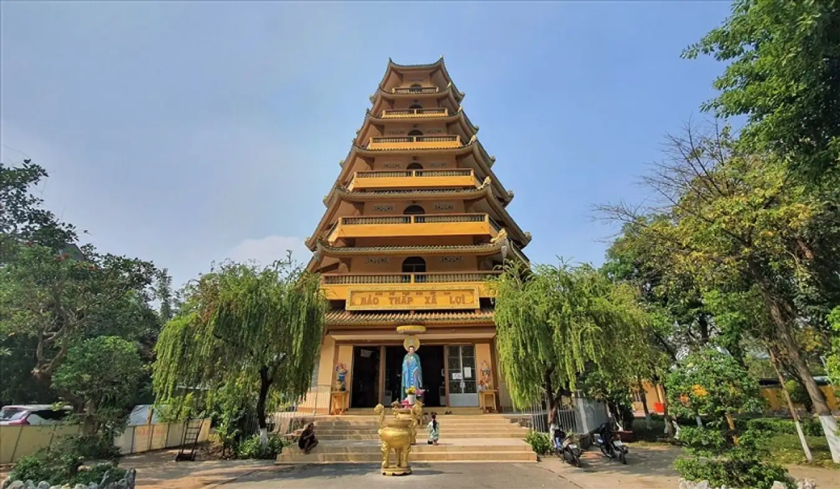
Where is Giac Lam Pagoda located?
Giac Lam Pagoda, one of the oldest pagodas in Ho Chi Minh City, is nestled in the peaceful Tan Binh District.
Located at 118 Lac Long Quan Street, Ward 10, Tan Binh District, Giac Lam Pagoda is easily accessible from various parts of the city.
How to get to Giac Lam Pagoda in Saigon
By Taxi or Ride-Hailing Services
For visitors opting for convenience and comfort, taking a taxi or using ride-hailing services like Grab or Gojek is a popular choice. Simply input the address “118 Lac Long Quan Street, Tan Binh District” into the app, and you’ll be on your way to Giac Lam Pagoda.
By Motorbike
For those who prefer the freedom of navigating the bustling streets of Saigon on their own, renting a motorbike is a fantastic option. With numerous rental shops scattered across the city, securing a motorbike for your journey to Giac Lam Pagoda is relatively easy.
By Public Transportation
Saigon’s public transportation network offers an economical way to reach Giac Lam Pagoda. Travelers can take a bus to the nearest bus stop, followed by a short walk to the pagoda. Additionally, the city’s expanding metro system will soon provide another convenient option for reaching this historic site.
By Guided Tours
Many tour companies in Ho Chi Minh City include Giac Lam Pagoda in their itineraries. Joining a guided tour not only ensures hassle-free transportation to the pagoda but also provides insightful commentary from knowledgeable guides, enriching your overall experience.
History of Giac Lam Pagoda in Tan Binh

Giac Lam Pagoda boasts a rich history dating back over three centuries, making it one of the oldest pagodas in Ho Chi Minh City and a significant cultural and religious landmark in Tan Binh District.
Origins
During the Nguyen Dynasty’s reign of Emperor Le Hien Tong, a monk named Ly Thuy Long originally constructed the pagoda in 1744. Initially known as “Cam Son Pagoda,” it underwent several renovations and expansions over the centuries, eventually evolving into the magnificent structure we see today.
Renaming to Giac Lam Pagoda
In 1774, a Buddhist monk named Venerable Thich Minh Tri suggested renaming the pagoda to “Giac Lam Pagoda.” The name “Giac Lam” is derived from two Sanskrit words, with “Giac” meaning “to enter” and “Lam” referring to the forest. Together, “Giac Lam” signifies a peaceful place where monks can retreat from worldly distractions to pursue spiritual enlightenment.
Throughout its long history, Giac Lam Pagoda has played a pivotal role in the development of Buddhism in Southern Vietnam. It served as a center for religious activities, meditation, and Buddhist teachings, attracting devotees and scholars from far and wide.
Preservation Efforts
Over the years, Giac Lam Pagoda has undergone numerous renovations and restoration projects to preserve its cultural and architectural heritage. Despite facing challenges such as natural disasters and urban development, the pagoda has managed to retain its original charm and continues to be a place of reverence and pilgrimage for Buddhists and visitors alike.
In recognition of its historical and architectural significance, Giac Lam Pagoda was designated as a National Cultural Historical Relic by the Vietnamese government in 1988, further cementing its status as a cherished cultural treasure in Tan Binh District and beyond.
Discover the Architecture of Giac Lam Pagoda in Saigon
Giac Lam Pagoda is renowned not only for its historical significance but also for its remarkable architectural design, which reflects the rich cultural heritage of Southern Vietnam. Let’s delve into the intricacies of its architecture:
The Unique Architectural Style of Pagodas in Southern Vietnam

Southern Vietnamese pagodas are known for their distinctive architectural style, characterized by intricate decorations, vibrant colors, and a harmonious blend of Buddhist and indigenous architectural elements. Giac Lam Pagoda is a prime example of this unique architectural tradition, featuring ornate carvings, elaborate motifs, and exquisite craftsmanship.
The Grand and Imposing Double Gate of Giac Lam Pagoda

A large double gate known as the “Cu Phc Gate,” which denotes auspiciousness and prosperity, welcomes visitors to Giac Lam Pagoda.with intricate wood carvings, depicting scenes from Buddhist scriptures, mythical creatures, and celestial beings, showcasing the skilled craftsmanship of local artisans.
Triple Gate
Beyond the double gate lies the triple gate, also known as the “Tam Quan Gate,” which serves as the main entrance to the pagoda complex. This majestic gate is flanked by two towering pillars and embellished with elaborate designs, including dragons, lotus flowers, and Bodhisattvas, reflecting Buddhist symbolism and spiritual aspirations.
The Characteristic Pyramid-Shaped Roof of the Pagoda

One of the most distinctive features of Giac Lam Pagoda is its characteristic pyramid-shaped roof, adorned with curved eaves, intricate roof tiles, and decorative finials. The roof design is reminiscent of traditional Vietnamese architecture and symbolizes the pagoda’s spiritual ascent towards enlightenment.
Main Hall
At the heart of Giac Lam Pagoda stands the main hall, or “Đại Hùng Thành Điện,” where devotees gather for prayers, ceremonies, and meditation. The hall is adorned with ornate altars, statues of Buddha and Bodhisattvas, and exquisite murals depicting Buddhist stories and legends, creating a serene and contemplative atmosphere.
Behind the Main Hall
Behind the main hall, visitors will find a tranquil garden dotted with bonsai trees, lotus ponds, and stone statues, providing a peaceful retreat from the hustle and bustle of urban life. This secluded area is ideal for meditation, reflection, and enjoying the natural beauty of the surroundings.
Attractions at Giac Lam Pagoda in Ho Chi Minh City
Giac Lam Pagoda, nestled in the bustling streets of Ho Chi Minh City, is not only a place of worship but also a treasure trove of cultural and architectural marvels. Here are some of the key attractions that draw visitors to this sacred site:
Xa Loi Stupa
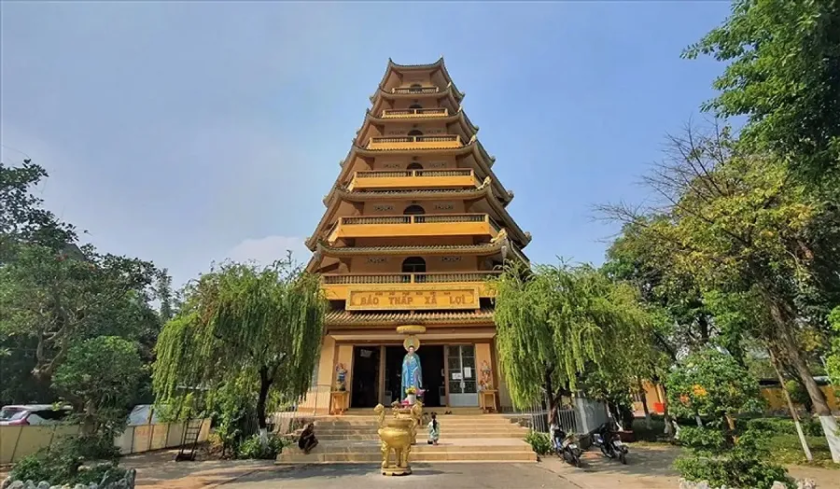
One of the most striking features of Giac Lam Pagoda is the Xa Loi Stupa, a towering seven-story hexagonal tower that stands at an impressive height of 32 meters. Built in 1994, this majestic structure houses ancient Buddhist relics and a majestic statue of Bodhisattva Avalokiteshvara. The stupa, with its intricate design and serene ambiance, serves as a focal point for contemplation and reverence.
Tranquil Garden and Bodhi Tree
Beyond the triple gate lies a serene garden adorned with a majestic Bodhi tree and statues of Buddhist deities, including the compassionate Bodhisattva Avalokiteshvara. This tranquil oasis provides visitors with a peaceful retreat from the bustling city life, inviting them to relax, meditate, and connect with nature amidst the sacred surroundings.
Main Hall and Altars

The main hall of Giac Lam Pagoda, known as the “Đại Hùng Thành Điện,” is a masterpiece of Vietnamese architecture, featuring intricate pillars, elaborate roof designs, and ornate decorations. Within the hall, visitors will discover three main sections: the main ceremonial hall, the altars of patriarchs, and the dining hall. Each section is adorned with sacred altars dedicated to various Buddhas and bodhisattvas, ancient statues, and priceless antiques dating back to the 18th and 19th centuries.
Altars of Patriarchs
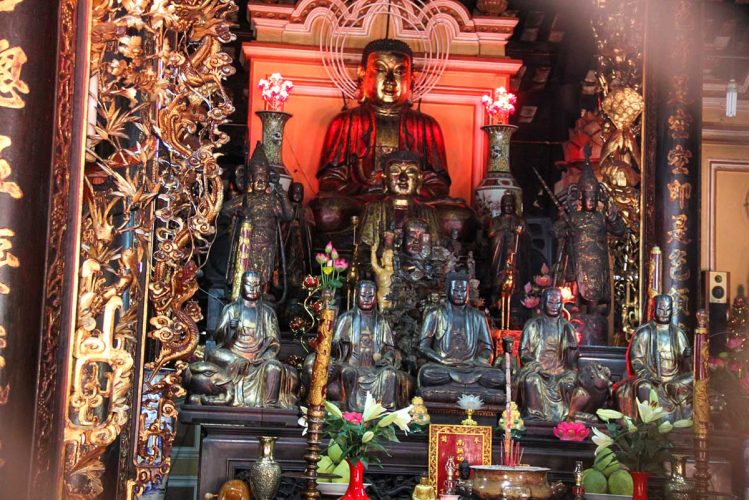
The altars of patriarchs hold significant historical and cultural value, serving as a testament to the rich heritage of Buddhism in Southern Vietnam. Visitors can admire plaques commemorating revered monks and abbots, showcasing the contributions and achievements of past generations in propagating the teachings of Buddha. These altars provide a glimpse into the evolution of Buddhism and its profound impact on the local community over the centuries.
Zen Hall and Stupas
In addition to the main hall, Giac Lam Pagoda boasts a Zen hall dedicated to Buddhist learning and meditation. Here, devotees can participate in spiritual practices, attend lectures, and engage in discussions on Buddhist philosophy and ethics. The complex also features multiple stupas honoring past abbots and spiritual leaders, adding to the spiritual and architectural richness of the pagoda.
When is the Best Time to Visit Giac Lam Pagoda?

Spring (February to April)
Spring is considered one of the best times to visit Giac Lam Pagoda, as the weather is mild and pleasant, making it conducive to outdoor exploration and leisurely strolls through the pagoda’s serene gardens. The blooming flowers and lush greenery add to the beauty of the surroundings, creating a picturesque backdrop for spiritual reflection and contemplation.
Autumn (September to November)
Autumn brings cooler temperatures and lower humidity levels to Ho Chi Minh City, providing relief from the sweltering heat of the summer months. The crisp, clear days of autumn are ideal for sightseeing, allowing visitors to explore Giac Lam Pagoda comfortably without being hindered by extreme weather conditions.
Additionally, the pagoda’s tranquil ambiance is accentuated by the gentle rustle of fallen leaves, creating a serene atmosphere for meditation and introspection.
Weekdays and Early Mornings
To avoid the crowds and fully immerse yourself in the tranquility of Giac Lam Pagoda, consider visiting on weekdays or during the early morning hours. During these times, the pagoda is less crowded, allowing visitors to explore its sacred halls and gardens at their own pace without feeling rushed or overcrowded.
Moreover, early mornings offer the opportunity to witness the pagoda’s serene beauty in the soft light of dawn, providing a unique and enchanting experience for spiritual seekers and photography enthusiasts alike.
Festivals and Special Events
Giac Lam Pagoda hosts a variety of festivals and special events throughout the year, including Buddhist holidays and cultural celebrations. These occasions offer a glimpse into Vietnam’s rich spiritual heritage and provide unique opportunities for cultural exchange and participation in traditional rituals and ceremonies.
Tips & Rules for Visiting Giac Lam Pagoda in Saigon
Visiting Giac Lam Pagoda offers a unique opportunity to immerse yourself in Vietnam’s rich Buddhist heritage and explore the architectural and spiritual wonders of this ancient site. To make the most of your visit and ensure a respectful and enjoyable experience, consider the following tips and guidelines:
- Modest Attire: As Giac Lam Pagoda is a place of worship, visitors are encouraged to dress modestly out of respect for the religious significance of the site. Avoid wearing revealing clothing such as shorts, sleeveless tops, or mini-skirts, and opt for clothing that covers your shoulders and knees.
- Footwear: Remove your shoes before entering the pagoda to adhere to Buddhist customs and keep the premises clean. Bring along a pair of socks if you prefer not to walk barefoot.
- Flash photography inside the pagoda halls, as it can disrupt the peaceful atmosphere and damage delicate artifacts and decorations.
- Silence and Respect: Maintain a quiet and respectful demeanor during your visit, especially within the pagoda halls and prayer areas. Avoid loud conversations, disruptive behavior, or any actions that may disturb other visitors or detract from the spiritual ambiance of the site.
- Observe Cultural Customs: Familiarize yourself with Vietnamese customs and traditions to show respect for the local culture and religious practices. Follow the guidance of temple staff and observe any specific rules or rituals associated with visiting Giac Lam Pagoda.
- Be Mindful of Others: Be considerate of other visitors, including worshippers and monks, and avoid behavior that may be deemed disrespectful or offensive. Cultivate an attitude of mindfulness and compassion towards all beings during your visit.
Relate blog
Relate blog
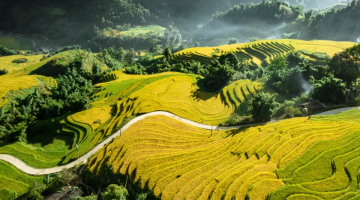
Located in the Ta Phin commune, Giang Ta Chai is regarded as one of Sapa’s most picturesque villages. Situated at…
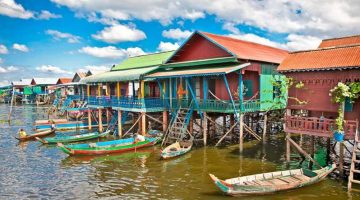
The Kampong Khleang Floating Village, tucked away in the center of Siem Reap Province, is a monument to the rich…

Quan Lan Island in Quang Ninh Province is a magnet for travelers seeking beautiful beaches, serene surroundings, and crystal-clear waters….

